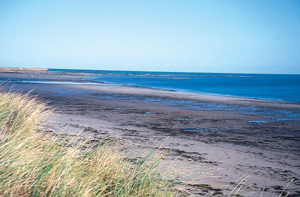 |
DRURIDGE Bay attracts anglers
 |
from all over the region who are up for a good day’s flattie bashing. The bay is some five miles long and is a fine example of one of the wonderful stretches of golden sands found in the north east of England.
There are massive rocky skeers at both ends of the beach that stand like sentinels protecting the bay. Needless to say, these rock edges can be brilliant when the winds are blowing strongly and a sheltered spot is the order of the day.
There is plenty of off-road parking among the sand dunes and all the marks are within easy reach.
The beach will produce good catches of various types of flatfish literally all-year-round. During the autumn and winter months cod, whiting, coalfish and pollack show in good numbers, especially at night when a good sea is running. In the past few years, bass have also been landed on a regular basis with fish to 6lb reported.
BONDI CARRS
The Bondi Carrs form a massive barrier at the northern end of beach and the main rock ledge goes out to sea for nearly half a mile. Running parallel some 100 yards from the high rocks is another skeer of high rock that forms a deep gully the full length of the mark. This trough can be very productive when the tide is ebbing. Often a 30-yard lob with big peeler crab bait will produce a plump cod and fish to double figures have been landed using this method. As the tide drops away and the gully empties, anglers will move along the rocks to fish the end skeers. Cod and coalfish are the main quarry from these marks with peeler crab, lugworm and various shellfish the top baits. Needless to say, great care should be taken when fishing this low water mark as the tide can creep in behind you, cutting off your retreat.
NEWBOROUGH BEACH
The sandy bay between the Bondi Carrs and Hadston Carrs is known as Newborough Beach. The rock edges situated either side of the beach give shelter from winter storms, and these marks can produce some excellent catches of fish. Fishing the hollows scoured out by the rough seas at low tide produces superb bags of quality cod to lugworm and peeler crab baits. At high water the variety of species taken can often improve dramatically with bass, plaice, flounder, coalfish and even the occasional pollack putting in an appearance.
HADSTON CARRS
The Carrs are made up of shelves of flat rocks, extending out into the North Sea for some distance, fringed with weed-covered boulders. This is ideal cod country and when conditions are right these marks can produce huge bags of fish. The weed beds conceal a mixture of small fish and crabs and this food supply attracts predatory species such as cod, ballan wrasse and pollack to the vicinity. At night the hotspots are often on the beach, on both sides of the Carrs, casting towards the offshore kelp jungle. The top bait when beach fishing is lugworm, while fresh peeler crab will take most of the fish from the rock edges.
DRIFT BURN
The Drift Burn is situated in the middle of the bay where an old opencast drainage system meets the sea. This area is popular with local surfers because of the strong currents present, and this tidal movement definitely attracts the fish. When seas are flat, flounder, dabs and plaice are the main species taken. During the autumn however, the gales whip up the seas and the beach can produce some outstanding catches of cod, coalfish and the occasional bass. Two hours either side of low water is the most productive period with lugworm and ragworm the top baits.
THE PLANTATION
The main road north from Cresswell follows the coast for a couple of miles before turning inland at the entrance to Druridge Bay Country Park. At this spot there is a line of rather decrepit trees, bent at odd angles by the strong prevailing winds. This is the Plantation and is used as a boundary line for many local fishing competitions. The beach fishing at this spot consistently produces good bags of mixed flatfish including flounder, dabs, turbot and plaice. At night when the sea is dropping away, following a few days of rough weather, the beach can produce some excellent bags of cod, coalfish, pollack and the occasional bass. Lugworm, ragworm and peeler crab often tipped with a sliver of mackerel are the best baits.
THE GREEN SKEERS
The Green Skeers are the only rocky feature on the entire beach. This area of flat, weed-covered rock runs along the beach for approximately 200 yards and is situated around the mid-tide mark. The stretch of rough ground attracts fish to the vicinity and is a popular flattie and whiting mark. During the winter when fish are inshore in good numbers, Green Skeers is one of the hotspots, often producing big catches of mixed species including codling, coalfish, bass and varieties of flatties.
TACKLE SHOPS
McDermott’s, Station Road, Ashington. Contact John on: 01670 812214
CD Tackle, 91 Front Street, Newbiggin by the Sea. Contact Cecil on: 01670 520133
Amble Angling Centre, Newburgh Street, Amble. Contact Sue or Bob on: 01665 711200





